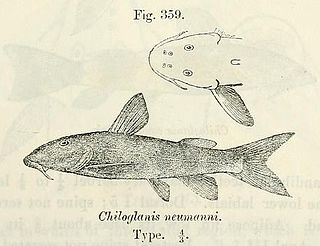
Chiloglanis is a genus of upside-down catfishes native to Africa. These species have modified lips and barbels that form a suckermouth. They also have a naked (scaleless) body. Sexual dimorphism has been reported in Chiloglanis. The adult males of many of these species have elongate anal and caudal fins. Also, males may have an enlarged humeral process.
Chiloglanis lufirae is a species of upside-down catfish endemic to the Democratic Republic of the Congo where it is found in the Lufira River drainage. This species grows to a length of 10 centimetres (3.9 in) SL.
Chiloglanis angolensis is a species of upside-down catfish endemic to Angola where it occurs in the Cuango River and the Rio Coroca. This species grows to a length of 5.6 centimetres (2.2 in) SL.

Chiloglanis batesii is a species of upside-down catfish found widely in Western and Central Africa. This species grows to a length of 4.7 centimetres (1.9 in) TL.
Chiloglanis benuensis is a species of upside-down catfish native to Cameroon and Nigeria where it occurs in the Niger, Bénoué and Chad River systems. This species grows to a length of 3.8 centimetres (1.5 in) TL.

Chiloglanis cameronensis is a species of upside-down catfish native to Cameroon, Equatorial Guinea and Gabon where they are found in the coastal rivers. This species grows to a length of 5.5 centimetres (2.2 in) TL.
Chiloglanis congicus is a species of upside-down catfish endemic to the Democratic Republic of the Congo where it occurs in the lower Congo River basin. This species grows to a length of 7.5 centimetres (3.0 in) TL.
Chiloglanis disneyi is a species of upside-down catfish endemic to Cameroon where it is found in the Mungo and Manyu River basins. It may also occur in the Cross River basin of Nigeria. This species grows to a length of 3.5 centimetres (1.4 in) SL.
Chiloglanis elisabethianus is a species of upside-down catfish endemic to the Democratic Republic of the Congo where it occurs in the rivers of Katanga (province). This species grows to a length of 5.2 centimetres (2.0 in) TL.
Chiloglanis lamottei is a species of upside-down catfish native to Guinea, where it is found at Mount Nimba, and Côte d'Ivoire, where it occurs in the Cavally River. This species grows to a length of 5 centimetres (2.0 in) SL.
Chiloglanis lukugae is a species of upside-down catfish endemic to the Democratic Republic of the Congo where it is found in the Luvua River drainage. Reports from other locations need confirmation. This species grows to a length of 9 centimetres (3.5 in) SL.

Chiloglanis modjensis is a species of upside-down catfish (Mochokidae) endemic to Ethiopia. This species grows to a length of 4 centimetres (1.6 in) SL.

Chiloglanis neumanni, the Neumann's suckermouth, is a species of upside-down catfish native to Central Africa. This species grows to a length of 6.5 centimetres (2.6 in) SL.
Chiloglanis niger is a species of upside-down catfish endemic to Cameroon where it occurs in the Niger River basin at Bamenda. This species grows to a length of 3.5 centimetres (1.4 in) SL.

Chiloglanis niloticus is a species of upside-down catfish native to the Nile River and Niger River. This species grows to a length of 4.5 centimetres (1.8 in) SL.
Chiloglanis occidentalis is a species of upside-down catfish that is native to western Africa. This species grows to a length of 6.2 centimetres (2.4 in) TL.
Chiloglanis pojeri is a species of upside-down catfish native to the Democratic Republic of the Congo where it occurs in the Lualaba River drainages and to Tanzania where it can be found in the Lake Tanganyika basin. This species grows to a length of 7 centimetres (2.8 in) TL.
Chiloglanis reticulatus is a species of upside-down catfish native to the Dja River system in Cameroon and the Luala and Lufu River drainages in the Democratic Republic of the Congo. This species grows to a length of 4.2 centimetres (1.7 in) SL.
Chiloglanis sanagaensis is a species of upside-down catfish endemic to Cameroon where it is only found in the Sanaga River basin. This species grows to a length of 4.3 centimetres (1.7 in) SL.
Chiloglanis voltae is a species of upside-down catfish native to Burkina Faso, Cameroon, Ghana, Nigeria and Togo, where it occurs in the Volta and Bénoué River systems. This species grows to a length of 2.7 centimetres (1.1 in) TL.









